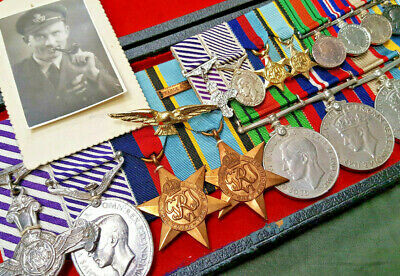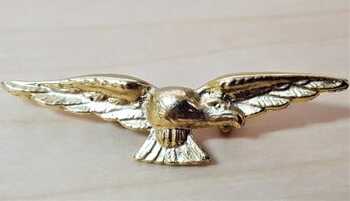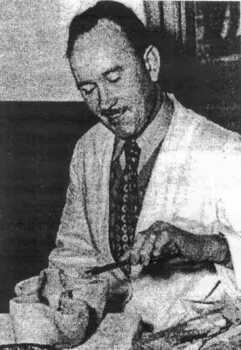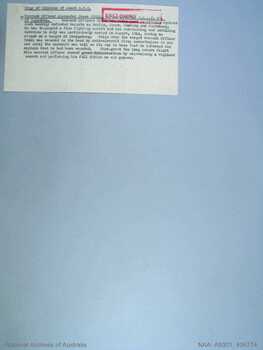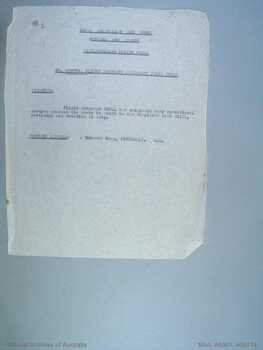CROLL [DFC,DFM,KGCV], Alexander James
Alexander James Croll, DFC, DFM flew two tours as a Lancaster rear gunner, as part of the Pathfinder force. Twice wounded in action – firstly as a WWII airman, then as a Korean War soldier – Alex Croll was the only Australian to receive a Korean Gold Cross of Valour (KGCV). Mr Croll lived the life of a solitary artist in Rivervale after returning from Korea in 1950. However, had he not been wounded that second time he may well have become a doctor. Instead, as a disabled ex-serviceman, he became a sculptor and potter. Mr Croll was born in Scotland and arrived in WA at the age of seven. He was educated at Rivervale Primary and Perth Boys Schools and studied Science at the University of WA until enlisting in the RAAF. His training was through the Empire Air Training Scheme at Pearce (WA), Pt Pirie (SA), and Canada, before he saw action over Europe. He was to have been a navigator, but opted for gunnery because that meant going into action sooner. His first tours were with Bomber Command’s Pathfinders. Between1942 and 1944 he flew 73 missions, most of them in Lancasters, as a rear and upper mid-gunner and was wounded by a flak burst over Konigsberg, East Prussia. Duties also included mine laying at the German ports of Hamburg, Bremen and Wilhelmshaven. He flew missions over Berlin – at one time, three in four days – Gdynia, Milan, the Ruhr, Nuremberg and Konigsberg. He participated in the famous 1000 bomber raid of August 1943 against Peenemunde, which was targeted after Polish agents alerted London that Hitler’s secret V-2 rockets were being developed there. The flak burst wounded him on the crown of his head and he had to have a metal plate inserted. While helping a wounded mate during a bayonet charge against Chinese and North Koreans at Chongju in October 1950, he was again wounded in the head. This resulted in paralysis of his right side and he had to walk using a caliper. Between his two tours of duty in different services he completed four years of a medical degree and excelled as a fencer. He volunteered for Korea as a private in the 3rd Battalion, Royal Australian Regiment, because he was too old for the RAAF. Mr Croll was awarded the KGCV in 1980 – receiving one of only 21 such medals struck. The origin of the belated KGCV dated back to 1950 when Ok Hyun Ahn, a South Korean soldier captured by the communists, was rescued by UN troops just before he was to have been executed.
Alexander James Croll, DFC, DFM flew two tours as a Lancaster rear gunner, as part of the Pathfinder force. Twice wounded in action – firstly as a WWII airman, then as a Korean War soldier – Alex Croll was the only Australian to receive a Korean Gold Cross of Valour (KGCV). Mr Croll lived the life of a solitary artist in Rivervale after returning from Korea in 1950. However, had he not been wounded that second time he may well have become a doctor. Instead, as a disabled ex-serviceman, he became a sculptor and potter. Mr Croll was born in Scotland and arrived in WA at the age of seven. He was educated at Rivervale Primary and Perth Boys Schools and studied Science at the University of WA until enlisting in the RAAF. His training was through the Empire Air Training Scheme at Pearce (WA), Pt Pirie (SA), and Canada, before he saw action over Europe. He was to have been a navigator, but opted for gunnery because that meant going into action sooner. His first tours were with Bomber Command’s Pathfinders. Between1942 and 1944 he flew 73 missions, most of them in Lancasters, as a rear and upper mid-gunner and was wounded by a flak burst over Konigsberg, East Prussia. Duties also included mine laying at the German ports of Hamburg, Bremen and Wilhelmshaven. He flew missions over Berlin – at one time, three in four days – Gdynia, Milan, the Ruhr, Nuremberg and Konigsberg. He participated in the famous 1000 bomber raid of August 1943 against Peenemunde, which was targeted after Polish agents alerted London that Hitler’s secret V-2 rockets were being developed there. The flak burst wounded him on the crown of his head and he had to have a metal plate inserted. While helping a wounded mate during a bayonet charge against Chinese and North Koreans at Chongju in October 1950, he was again wounded in the head. This resulted in paralysis of his right side and he had to walk using a caliper. Between his two tours of duty in different services he completed four years of a medical degree and excelled as a fencer. He volunteered for Korea as a private in the 3rd Battalion, Royal Australian Regiment, because he was too old for the RAAF. Mr Croll was awarded the KGCV in 1980 – receiving one of only 21 such medals struck. The origin of the belated KGCV dated back to 1950 when Ok Hyun Ahn, a South Korean soldier captured by the communists, was rescued by UN troops just before he was to have been executed.

